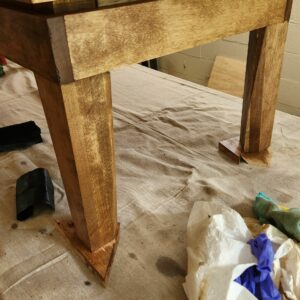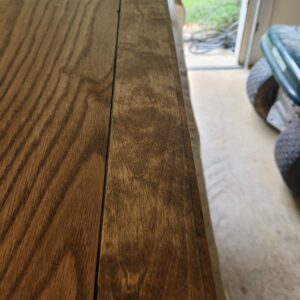Hello from Western NC!
I recently completed a project coffee table made out of birch and oak veneer centerpiece. Long story short I followed the manufactures instructions on applying one coat of Watco’s Dark Walnut Danish Oil and the birch came out terribly blotchy. I guess I broke the cardinal rule by not using a pre-stain conditioner. I did try wet sanding some pieces with additional danish oil but it didn’t seem to make enough of a difference to continue.
I know one option is to sand it back down to the bare wood and starting over, but I am a little concerned about sanding through the oak. I am also concerned that even if I do start over with a preconditioner it will still blotch using the Watco.
Is it also possible to put something on top of the oil to cover up the blotchy finish? Such as a dye or something else? Open to any ideas at this point as I am chalking this up to a learning experience but would still like to use the table.
P.S. I know its the different absorption rates of the wood and not specifically Watco to blame. Blame is on me for not taking this into account.

















Replies
I have never used conditioners prior to stain, never had problems. The most important factor in finishing is wood preparation. It is obvious from the pictures that sanding has not been sufficient to even the wood texture. Either the machining was too rough or sanding inadequate or both.
I think the cardinal rule you broke or it at least it is my rule.
Don't stain light woods, (or softwoods).
If you want dark wood, start with dark wood and use stain to even out the color.
I would paint that base, leave the top alone and move on.
I've never used a wood conditioner either.
Birch and pine mottled badly. I only tried to stain either one once, and wouldn't do it again. The only thing I use a dye on is curly maple.
"Wood conditioner" is just thin finish. It keeps the wood from absorbing a lot if the stain. Sanding more thoroughly and to finer grits will do a better job of evening out stain uptake.
I know it's too late for this project, but rather than staining birch to look like the oak, just use oak.
About 20 years ago, I made a mission style bed for our daughter. It came out great, except that I made it out of pine and the finish was somewhat blotchy. Big disappointment after all that work. I used wood conditioner prior to stain and it only helped a little. As others have mentioned, using hardwoods with no staining or coloring will yield much better results. Surface prep by planing and card scraping also helps. Always do a test first on scrap wood. Shellac also works well as a sealer and can be applied either before or after an oil finish like Watco. In your case, shellac first might have done the trick.
To salvage your project, you might try lightly sanding and painting with milk paint followed by boiled linseed oil, if you would like a 19th century look. You may need to reapply the BLO fairly often on horizontal surface, though, if the table sees hard use.
It looks exactly like those species are supposed to look when finished with oil. I actually love the way it turned out and would have that in my home in a heartbeat.
I wouldn't worry about it. You're too used to the toned, gloppy, film-forming finishes for mass manufactured furniture that allows the manufacturer use almost any species he cares to use and they all end up looking the same.